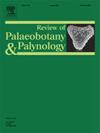早白垩世(Aptian晚期)巴西Araripe和jatob盆地的孢粉区系:生物地层学和沉积控制
IF 1.7
3区 地球科学
Q2 PALEONTOLOGY
引用次数: 0
摘要
上阿普田的桑塔纳群记录了Araripe盆地和jatob本文章由计算机程序翻译,如有差异,请以英文原文为准。
Palynoflora of the Araripe and Jatobá basins (Brazil) during the Early Cretaceous (late Aptian): Biostratigraphy and depositional controls
The Santana Group, Upper Aptian, records the post-rift stage of the Araripe and Jatobá basins. The palynological zones and its geological evolution is still controversial and requires review as new information becomes available. Palynological analysis play a crucial role in petroleum geology in Brazilian basins, as it allows for the reconstruction of paleoenvironmental conditions, stratigraphic correlation, and the definition of ages and potential areas for hydrocarbon exploration. This study integrates sedimentological and palynological data from drill cores in the Araripe and Jatobá basins, which consist of siliciclastic rocks intercalated with limestons e and evaporites intervals. Our analysis is used here to refine the temporal interval and depositional conditions of the late Aptian sequences of such basins. Palynological analysis resulted in the identification of 159 taxa and suggests the presence of the Sergipea variverrucata Biozone (P-270). The late Aptian is defined by their last occurrence of S. variverrucata. The presence of marine palynomorphs (e.g., Subtilisphaera sp. and foraminiferal test linings) indicates marine incursions into the basins. Based on palynological associations and sedimentary facies, the Santana Group consists of a fluvio-deltaic transitioning from a semi-enclosed lagoon and shallow marine environments deposited during the Early Aptian. Additionally, foraminiferal test linings in samples from the Crato Formation have been recorded, reinforcing marine incursions into the basins.
求助全文
通过发布文献求助,成功后即可免费获取论文全文。
去求助
来源期刊
CiteScore
3.50
自引率
21.10%
发文量
149
审稿时长
6 months
期刊介绍:
The Review of Palaeobotany and Palynology is an international journal for articles in all fields of palaeobotany and palynology dealing with all groups, ranging from marine palynomorphs to higher land plants. Original contributions and comprehensive review papers should appeal to an international audience. Typical topics include but are not restricted to systematics, evolution, palaeobiology, palaeoecology, biostratigraphy, biochronology, palaeoclimatology, paleogeography, taphonomy, palaeoenvironmental reconstructions, vegetation history, and practical applications of palaeobotany and palynology, e.g. in coal and petroleum geology and archaeology. The journal especially encourages the publication of articles in which palaeobotany and palynology are applied for solving fundamental geological and biological problems as well as innovative and interdisciplinary approaches.

 求助内容:
求助内容: 应助结果提醒方式:
应助结果提醒方式:


